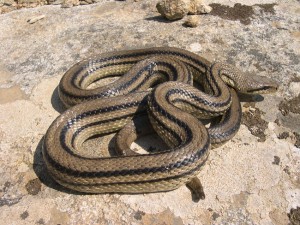A Column of Burning Snakes August 2, 2010
Author: Beach Combing | in : Ancient, Modern , trackback
Beachcombing has before him on his desk a volume from Frazer’s Golden Bough, perhaps the most famous work of comparative mythology ever written. In it Frazer quotes from Athenaeum (1869) concerning a difficult to forget and cruel bonfire.
At Luchon in the Pyrenees on Midsummer Eve: a hollow column, composed of strong wicker-work, is raised to the height of about sixty feet in the centre of the principal suburb, and interlaced with green foliage up to the very top; while the most beautiful flowers and shrubs procurable are artistically arranged in groups below, so as to form a sort of background to the scene. The column is then filled with combustible materials, ready for ignition. At an appointed hour–about 8 P.M. – a grand procession, composed of the clergy, followed by young men and maidens in holiday attire, pour forth from the town chanting hymns, and take up their position around the column. Meanwhile, bonfires are lit, with beautiful effect, in the surrounding hills. As many living serpents as could be collected are now thrown into the column, which is set on fire at the base by means of torches, armed with which about fifty boys and men dance around with frantic gestures. The serpents, to avoid the flames, wriggle their way to the top, whence they are seen lashing out laterally until finally obliged to drop, their struggles for life giving rise to enthusiastic delight among the surrounding spectators. This is a favourite annual ceremony for the inhabitants of Luchon and its neighbourhood, and local tradition assigns it to a heathen origin.
Frazer had no hesitation, doubtless encouraged by the last sentence, in linking this to ancient druidic ceremonies – Caesar’s wicker men burning sacrificial victims alive.
However, Frazer was forever tracing early modern and modern customs back into the mists of time, even when they were sometimes recent inventions. Indeed, Beachcombing has no doubt that were Frazer to walk around Beachcombing’s village of Little Snoring today the great Scottish folklorist would find something Anglo-Saxon in the dog ends littering the park and some Punic fertility ritual in the misted up car windows of courting couples.
Whether or not there really was an ancient ritual behind the fire at Luchon it would be interesting to know more about how it operated and how it changed over time, preferably from a French source. Another British account from 1901 (Speakman) helps, revealing that, though the burning continued, the custom of torturing snakes died out in the late nineteenth century.
I was also told that until very recent times it had been the custom to imprison couleuvres (a non-poisonous snake), and toads and even apes [B. God knows what Frazer would have made of this!], within the Brandon, which caused great entertainment (!) by their efforts to escape this horrible death, jumping out in all directions and wriggling higher and higher as the flames approached them, only to be caught and cast back into the fire. And it seemed that no human feeling of pity for the reptiles would have caused a cessation of the hideous sport, but on one occasion a large couleuvre in agony leapt upon the back of a woman who stood unwarily near, and the woman died on the spot from fright.
Beachcombing doesn’t believe the snake-scared woman story. But it is interesting how in the thirty years between 1869 and 1901 legends continued to swirl around this festival explaining a change in Frazer’s ‘druidic’ rituals.
Beachcombing has come across references to the festival in 1939 but none from later. Did it survive the SWW? drbeachcombingATyahooDOTcom



